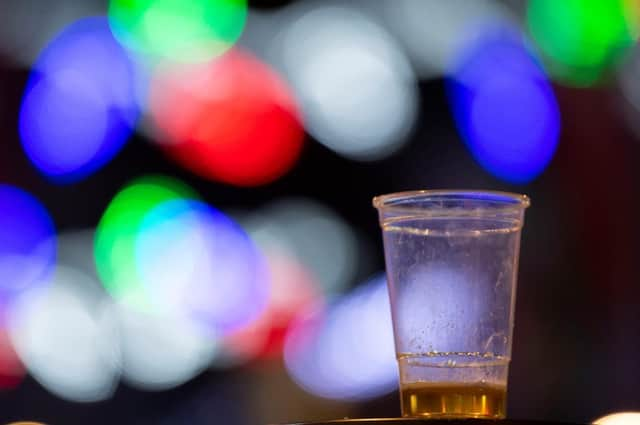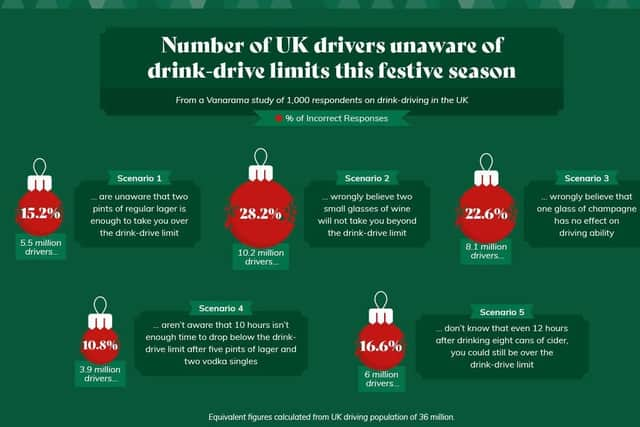You could be fined £2,500 for standing next to a car after drinking


With that also comes 11 months’ worth of social events packed into just four weeks, from work parties to Black Eye Friday celebrations.
As such, the police are usually especially keen to stress drink-driving awareness this time of year.
Advertisement
Hide AdAdvertisement
Hide AdOn the cusp of 2021’s festivities kicking off, Vanarama surveyed 1,000 UK adults on their knowledge of the current drink-drive limits to find out just how many have no idea they could be putting themselves and others at risk.


A Third Of Drivers Could Get Behind The Wheel After Champagne On Christmas Day
Vanarama presented 1,000 respondents with five scenarios, from the office party to a tipple with Christmas dinner, breaking down the proportions of those with false confidence in the law.
The responses show that one in five UK adults – or eight million drivers – have no clue that it takes just two small glasses of wine to take your blood alcohol concentration (BAC) beyond the England, Wales and Northern Ireland limit of 0.08%, or 80mg of alcohol for every 100ml of blood. In Scotland, that limit is 0.05% and 50mg of alcohol.
Advertisement
Hide AdAdvertisement
Hide AdWorse still is that nearly a third of respondents believe a glass of champagne with the Christmas Day roast would have no effect on their ability to drive. Against the UK driving population (36 million), that means just over 10 million drivers could be risking it this year.
Applied to the population as a whole, as many as 19 million UK adults could be the driver or passenger of a car operated under the influence of alcohol on Christmas Day.
Four Million Drivers Could Be At Risk The Morning After A Christmas Party
Participants were also quizzed on the amount of time required for your body to process alcohol and drop below the drink-drive limit. When asked if 12 hours was enough to stabilise your BAC after five pints of lager and two vodka singles at the work Christmas party, more than one in 10 were confident it was.
Advertisement
Hide AdAdvertisement
Hide AdIn actual fact, this level of alcohol could take up to 50% longer, meaning four million drivers could be caught red-handed the day after work festivities this year.
You’re 11 Times More Likely To Die In A Vehicle Crash If You Drive Over The Limit
Affecting reaction times, coordination, vision and even our judgement, alcohol is best served without driving. According to independent charity Drinkaware, even drivers with a BAC of less than 0.05% (roughly one and a bit pints of lager) have a three-times risk of dying in a vehicle crash. Those between 0.08% and 0.10%, equivalent to only three or four pints, are 11 times more likely to die in a crash.
Although there’s been a drop in recent years, 7,800 people are estimated to have been killed or injured in 2019 when at least one driver was over the limit, according to the Department for Transport’s latest published statistics.
Advertisement
Hide AdAdvertisement
Hide AdJust Standing By Your Car While Drunk Can Land You In Prison For Three Months
Drink-driving punishments are just as sobering, however, as even standing by your car while intoxicated can result in three months’ imprisonment, up to £2,500 in fines and a possible driving ban. Actually driving or attempting to drive under the influence raises those to six months’ imprisonment, unlimited fines and a driving ban of at least one year, or three if you’re convicted twice within a decade.
Causing death by careless driving while intoxicated could result in 14 years behind bars, unlimited fines, and a two-year minimum ban. You’ll also have to complete an extended driving test before the licence is returned.
Six Tips For Staying Safe On The Roads This Christmas
Despite the many celebrations at this time of year, especially after the write-off that was Christmas 2020, it’s worth knowing your limits – both personal and those related to drink-driving.
Advertisement
Hide AdAdvertisement
Hide AdFor the full avoidance of doubt, don’t drive after any amount of alcohol – even if it’s only a few mouthfuls of lager. This is unlikely to put you over the limit but could still affect your driving ability. Alcohol-free alternatives, such as mocktails and Heineken 0.0, are a safer option.
If you need to drive, keep below the drink-drive limit. Two pints of standard lager or two small glasses of wine is all it takes to teeter over, so opt for two lager shandies or a small wine spritzer – or safer still, avoid drinking altogether if you’re driving.
There really is science behind ‘lining the stomach’. A full stomach before drinking can slow the absorption of alcohol and help manage your blood alcohol concentration (BAC) better. Even if you won’t be driving until the day after, this is recommended.
Have a soft drink or glass of water every other drink or at regular intervals. Overall, you’ll still feel the merry effect of alcohol but won’t be consuming as much of it. Regardless of how much you’ve eaten, however, make sure to stay within the drink-drive limit and avoid driving the day after a heavy night out.
Advertisement
Hide AdAdvertisement
Hide AdGive your body plenty of time to process the alcohol the following day. Especially after a heavy session, seven or eight hours of sleep likely won’t be enough to bring you below the drink-drive limit. Free online tools, such as the Morning After Calculator, can estimate how long a range of drinks will stay in your system.
For the full better-safe-than-sorry approach, consider buying your own alcohol breathalyser. The Alcosense Lite2, for example, is available from several UK retailers for less than £50 – a small cost for total peace of mind.
How Much Do I Need To Drink To Be Over The Limit?
So, we know the UK’s drink-drive limit is 80mg of alcohol for every 100ml of blood (or 50mg for Scottish motorists), but how does that translate into actual drinks? Below are some common choices and how many hours it takes one helping to be processed by the body.
Just one large glass of wine - five hours required before driving.
Double vodka - four hours.
Sex on the Beach - four hours.
Pint of cider - four hours.
Long Island Iced Tea - three and a half hours.
Pint of lager - three and a half hours.
Pina Colada - three hours.
Can of lager - three hours.
Glass of champagne - two and a half hours.
Single gin - two and a half hours.
Figures from morning-after.org.uk.
Advertisement
Hide AdAdvertisement
Hide AdAlthough one serving of each of the above wouldn’t necessarily take you beyond the drink-drive limit, the time required shows how long alcohol can hang about in your system. Perhaps most surprising is that a large glass of wine, at five hours, takes longer to process than the likes of a Long Island Iced Tea or double vodka.
Even the least potent single gin would need two and a half hours to be undone.